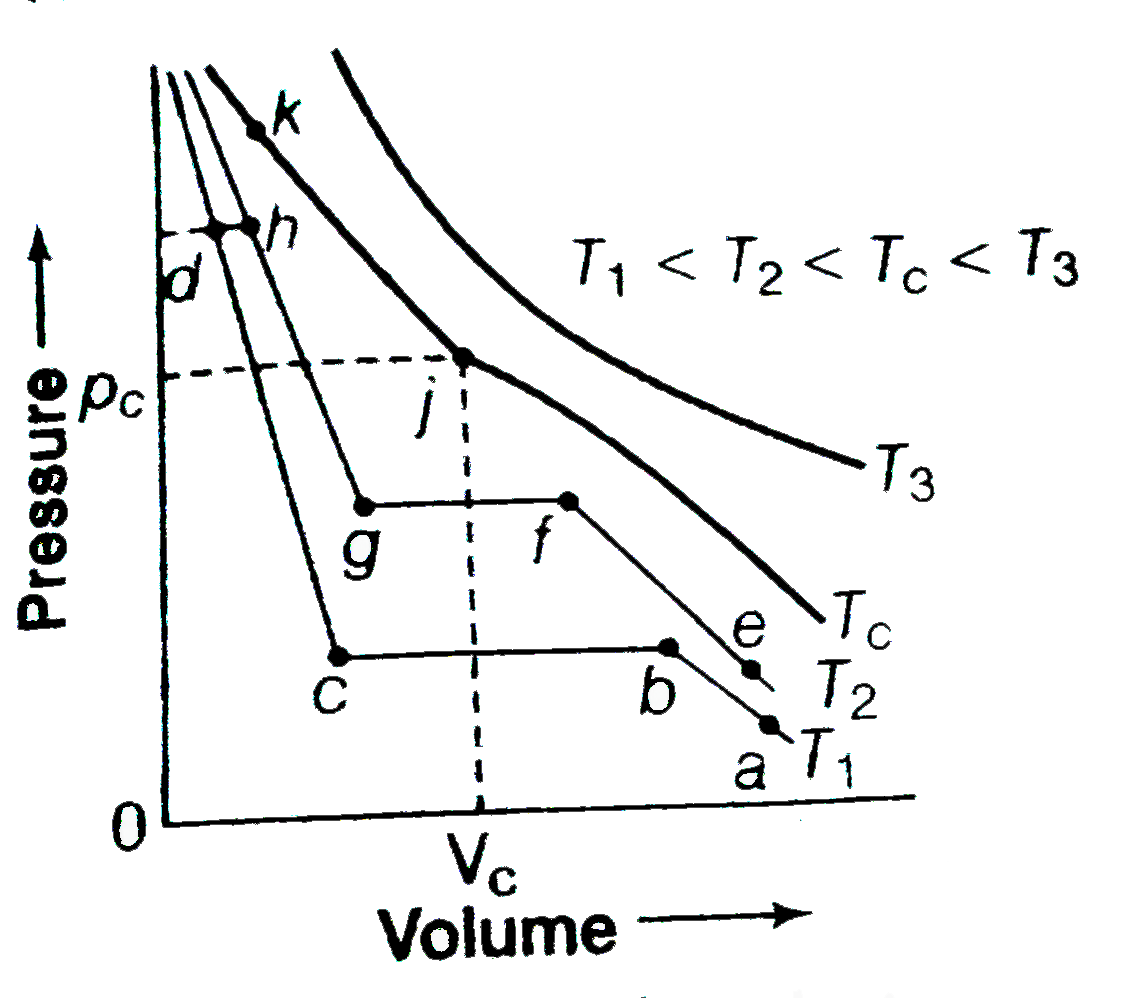Complete Solutions to NUMERICAL PROBLEMS of chapter STATES OF MATTER : GASES AND LIQUIDS of Class 11 book with complete answers and questions
| Class 11 | CHEMISTRY |
| Chapter | STATES OF MATTER : GASES AND LIQUIDS |
| NOOTAN | NUMERICAL PROBLEMS |
| Number Of Questions | 20 |
| Academic Year | 2023-24 |
Isotherms of carbon dioxide at various temperatures are repersented in figure. Answer the following questions based on this figures.

(i) In which state will `CO_(2)` exist between the points a and b at temperature `T_(1)` ?
(ii) At what point will `CO_(2)` start liquefyinh when temperature is `T_(1)` ?
(iii) At what point will `CO_(2)` be completely liquefued when temperature is `T_(2)` ?
(iv) Will condensation take place when the temperature is `T_(3)` ?
(v) What portion of the isotherm at `T_(1)` represent liquid and gaseous `CO_(2)` at equilibrium ?
View SolutionThe volume of an air bubblebecomes three times as it rises from the bootom of a lake to its surface. Assuming temperature to be constant and atmospheric pressure to be 75 cm of Hg and the density of water to be `1//10` of the density of the mercury, the depth of the lake is
View SolutionAt S.T.P. a mixture of 280 mL of `CH_4 " and 140 mL of " H_2` is completely burnt. Calculate the required volume of oxygen and weight of water formed, assuming that whole of the steam condenses to water.
View SolutionCalculate the pressure exerted by 0.250 moles of carbon dioxide in 0.275 litres at `100^@C` and compare this value with that expected for an ideal gas.
(Given : `a = 3.59 L^2 " atm " mol^(-2), b = 0.0427 L mol^(-1)`)
View SolutionCalculate the relative rates of diffusion of `""^235UF_6 and ""^238UF_6` in gaseous form (F= 19).
View SolutionAn iron cylinder contains helium at a pressure of 250 k Pa at 300 K. The cylinder can withstand a pressure of `1 xx 10^6` Pa. The room in which cylinder is placed catches fire. Predict the temperature (in K) at which the cylinder will blow up before it melts or not (m.p.t. of the cylinder =1800K)..
View SolutionA 4: 1 molar mixture of He and CH4 is contained in a vessel at 20 bar pressure. Due to a hole in the vessel, the gas mixture leaks out. What is the composition of the mixture effusing out initially?
View SolutionWhat will be the density of carbon dioxide at `100^@C` and 800 mm Hg pressure ?
View SolutionA gas occupies 300.0 mL at `27^@C` and 730 mm pressure. What would be its volume at standard temperature and pressure (S.T.P.) ?
View SolutionA certain quantity of a gas occupies 300 mL when collected over water at `25^@C` and 745 mm pressure. It occupied 182.6 mL in dry state at S.T.P. Find the vapour pressure of water at `25^@C`.
View SolutionA gas bulb of 1 litre capacity contains `2.0 xx 10^(21)` molecules of nitrogen exerting a pressure of `7.57 xx 10^3 Nm^(-2)` . Calculate the root mean square speed and the temperature of gas molecules. If the ratio of most probable speed to the root mean square speed is 0.82, calculate the most probable speed for the molecules at this temperature.
View SolutionIn a Victor Meyer's determination, 0.23 g of a volatile substance displaced air which measured 112 mL at S.T.P. Calculate the vapour density and molecular weight of the substance (1 litre of `H_2` at S.T.P. weighs 0.09 g).
View SolutionAt room temperature, ammonia gas at 1 atm pressure and hydrogen chloride gas at P atm pressure are allowed to effuse through identical pin holes from opposite ends of a glass tube of one metre length and of uniform cross section. Ammonium chloride is first formed at a distance of 60 cm from the end through which HCl gas is sent in. What is the value of P?
View SolutionAn open vessel contains air at `27^@C`. To what temperature should the vessel be heated so that the number of molecules in the vessel decreases by 25% ? (Neglect the expansion of the container).
View SolutionCalculate the average kinetic energy in joules of the molecules in 8.0 g of methane at `27^@C`.
View Solution3 moles of a gas are present in a vessel at a temperature of `27^@C`. What will be the value of R, the gas constant, in terms of the kinetic energy of the molecules of the gas ?
View Solution`1470 cm^3` of a gas is collected over water at 303 K and 74.4 cm of Hg. If the gas weighs 1.98 g and vapour pressure of water at `30^@C` is 3.2 cm of Hg, calculate the molecular weight of the gas.
View SolutionA certain gas occupies 0.418 litres at `27^@C` and 740 mm Hg.
What is the volume at S.T.P. ?
View SolutionA certain gas occupies 0.418 litres at `27^@C` and 740 mm Hg.
If the same gas weighs 3.00 g, what is its molecular weight?
View SolutionA certain gas occupies 0.418 litres at `27^@C` and 740 mm of Hg.
If we increase the weight of the gas to 7.5 g in the same vessel and the temperature is changed to 280 K, what would be its pressure ?
View Solution
NUMERICAL PROBLEMS questions and complete solutions for chapter STATES OF MATTER : GASES AND LIQUIDS of NAGEEN CHEMISTRY (ENGLISH) of Class 11
All Exercises from NOOTAN Class 11 CHEMISTRY STATES OF MATTER : GASES AND LIQUIDS
- ASSERTION-REASON TYPE QUESTIONS
- ESSAY (LONG ANSWER ) TYPE QUESTIONS
- Example
- FILL IN THE BLANKS. TYPE QUESTIONS
- NCERT TEXT-BOOK EXERCISES (With Hints and Solutions)
- NUMERICAL PROBLEMS
- OBJECTIVE (MULTIPLE CHOICE) TYPE QUESTIONS
- REVIEW EXERCISES
- SHORT ANSWER TYPE QUESTION
- TRUE OR FALSE TYPE QUESTION
- VERY SHORT ANSWER TYPE QUESTIONS